Geographical Indications and Designations of Origin
What are geographical indications?
They are names that identify products, which have been produced in a specific place, with unique characteristics, linked to that geographical origin and traditional know-how. Therefore, when they have a specific link to their place of production, product names can be recognised as a “geographical indication”.
These indications give consumers confidence and enable them to distinguish quality products, while helping producers to market their products better.
There are almost 3500 registered geographical indications in the European Union. Geographical indications for agricultural products and foodstuffs, wines and spirits are currently regulated by three separate EU Regulations. For other products, such as textiles, ceramics or glass, a proposal for an EU Regulation is underway.
What are designations of origin and what distinguishes them from other indications?
Geographical indications include protected designations of origin (PDOs) and protected geographical indications (PGIs).
The link with the geographical area is stronger for PDOs than for PGIs, since in PDOs all production stages take place in that area and the characteristics of the product are essentially due to that area. Despite this difference, the regulation and legal protection of PDOs and PGIs is the same.

An example of a PDO is “Aceite – Oli de Terra Alta”, an extra virgin olive oil obtained from the fruit of Olea Europea L., the main variety Empeltre or the blend of the Empeltre variety and the secondary varieties Arbequina, Morruda and Farga. The production area includes the region of Terra Alta and some municipalities in the region of Ribera d’Ebre (Catalonia).
Other well-known PDOs refer to wines, such as “Ribeiro” (Galicia), “Cava” (Catalonia) or “Arabako Txakolina-Chacolí de Álava” (Basque Country).
An example of a PGI would be ‘Irish Whiskey’, which is made, distilled and aged in Ireland, without the raw materials needing to be sourced exclusively from Ireland.
How can we assist you?
- Designations of Origin, Geographical Indications, traditional wine terms and Traditional Specialities Guaranteed are absolute grounds for refusal of Trademarks and Trade Names. In the event of a conflict at registration level, we examine the ex officio objection or the opposition of a Regulatory Council.
- We advise Regulatory Councils and producers in the field of agriculture and viticulture on the correct protection of their distinctive signs.
How can we assist you?
- Designations of Origin, Geographical Indications, traditional wine terms and Traditional Specialities Guaranteed are absolute grounds for refusal of Trademarks and Trade Names. In the event of a conflict at registration level, we examine the ex officio objection, the opposition or observations submitted by a Regulatory Council or other concerned institutions.
- We advise Regulatory Councils and producers in the field of agriculture and viticulture on the correct use and protection of their distinctive signs.







